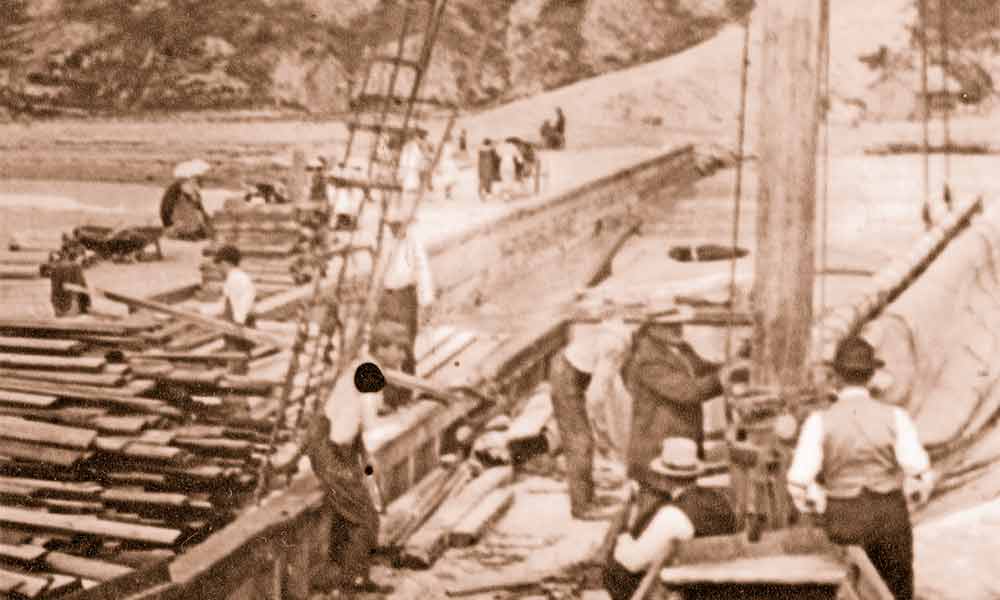Cantin’s rationale for the wharf was based on:
- needing a distribution point for products from St. Joseph’s brickyard, lumber mills and future industrial firms, and
- a contribution towards a program to attract French Canadians back to Canada.
At the time, Canada was spending money to attract emigrants from around the world to come and settle here. The idea of encouraging French-Canadians “home” and to further encourage them to settle in St. Joseph was attractive to Tarte. Cantin told Tarte that 25 French-Canadian expatriate families had already settled in St. Joseph.
“I think it is an interesting place, I believe there will be large immigration there. We are paying large sums of money to bring people from Russia, Poland and all parts of the world, and I thought it would be a good thing to bring a few dozen French Canadians to invade Ontario” — J. Israel Tarte.
Tarte’s engineering department conducted a survey and concluded $5,000 would build the wharf and provide a 10-foot deep (3.048 m) channel of water. Tarte included the $5,000 estimate in his budget requirements for 1902. The wharf was debated in the House of Commons at length on March 14, 1902, requiring 14 pages of Hansard Transcripts.
John Sherritt, North Middlesex Tory member, led an opposition attack claiming there was no immigration from Chicago to St. Joseph. Sherritt quoted the Brussells Post as saying “a harbour is not required there, nor is there any probability of it ever being used if it were there. St. Joseph needs a harbour as badly as a goose needs side pockets”.
Dr. Thomas Sproule, member for Grey County, suggested there was not enough depth, “a gentleman told me he could roll up his pants and walk out twenty rods without wetting them”.
Tarte promised to visit St. Joseph to inspect the site and asked the House to approve the $5,000, stating he would not spend the money if the site were unsatisfactory. The opposition continued to oppose the wharf and finally Prime Minister Laurier urged a decision, feeling the matter did not deserve so much of the House’s time. Tarte’s budget was approved; Tarte visited St. Joseph. He concluded St. Joseph would be a good harbour location since Bayfield’s harbour was too shallow.
Government Project Runs Over-Budget
Instead of the estimated $5,000, $10,000 was spent causing another parliamentary debate. Sherritt argued the money would be better spent at Grand Bend, “a very extensive summer resort with active industries”. George McEwen, member for South Huron argued there was nothing at St. Joseph to warrant the extra expense. The additional expenditure was approved.
Cantin replied to the latest debate in the Toronto Star, labeling McEwen and Sherritt’s suggestions that St. Joseph was an unfit location for a wharf to be “abominable untruth””. Cantin insisted St. Joseph was eminently suited for a wharf, having no sand bars or river deposits and having the necessary depth.
“The natural advantages for a harbor are better than at any other point on the Canadian shore of Lake Huron, being situated as it is on a circular bay with deep water close in shore, clay bottom free from rocks, and sand bars, river deposits, and such obstacles as are encountered at other places, where rivers flow into the lake…Over twenty-thousand vessels pass St. Joseph annually.” — Narcisse Cantin
The wharf ultimately cost $15,000.
St. Joseph had its government wharf until 1955 when the Governor-in-Council “was pleased to declare that the Crown ceased to be in control or occupation of the wharf at St. Joseph, Huron County”.
Lake Huron’s storms, waves, ice and wind had ensured maintaining the wharf troublesome.

